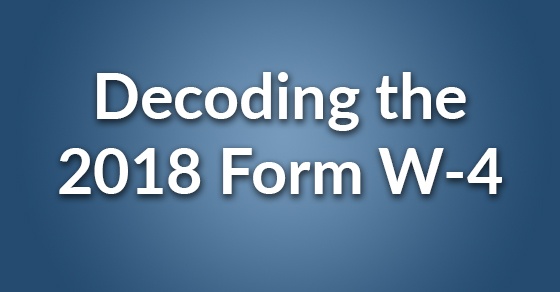
Disclaimer: HomeWork Solutions employees are experts in Employment Taxes, not personal income taxes. That said, we see these forms every day. If you have specific questions please see your personal tax accountant for more 2018 W-4 help.
First off, here is a link to the IRS maintained version of the Form W-4.
This new version has substantial changes. Even some elements that haven’t changed have been rearranged on the new 2018 federal W-4 form. Starting from the top we do see some familiar things (provided you’ve read the “fine print” of the form before). The general instructions haven’t changed much but there are some clarifications about the adjusted child care tax credit as well as credits for other dependents. You’ll notice then that the bottom third of the first page is now the Employee Withholding Allowance Certificate with no allowance worksheet above it. The section is still the same with name, address, social security number, etc. The most important things here are filing status (box 3) and number of allowances (box 5), the same as it has always been. The major difference is that getting to your number of allowances is considerably more difficult.
Finding Your Allowances (Exemptions)
In the news leading up to the Tax Cuts and Jobs Act, we were told that personal allowances would go away completely. Well… that’s not completely true. If you are married and filing jointly get ready to read the instructions carefully. Page two of the form gives more details and clarifications, read through it to see what worksheet(s) you need to fill out. If you are filing as single, things are pretty well the same as they have been, the Personal Allowances Worksheet hasn’t changed much. Take care to note the income brackets for dependent care credits, if they apply to you, as those have changed.
If you plan to itemize your return (remember the standard deduction nearly doubled for 2018 so you might not itemize even if you did for previous years) you will need to go through the Deductions, Adjustments, and Additional Income Worksheet, regardless of filing status. Here you will need to estimate your 2018 itemized deductions and break out your arithmetic skills. You will also need to estimate any interest, dividends, etc you may receive. Once you have those estimates there is some adding, subtracting, and dividing to be done before coming to a number of allowances, that is, unless you are living in a two income household…
If you are married filing jointly where both parties have jobs, or if you have two+ jobs yourself, you will likely need to complete the Two-Earners/Multiple Jobs Worksheet on page four (4). Here you will need the result from the worksheet you just finished and estimates of earnings for all jobs in the household. Use the tables provided as instructed to see how many allowances to claim on your form. If you are claiming fewer allowances than the table allows for the lowest paying job in the household (even if you are the higher earner) you may still need to have additional tax withheld from your paychecks. Step 4 onward helps you figure out that additional withholding, if needed. It is worth mentioning that if you are paid every two weeks you will have 26 pay periods in a year, if you are paid weekly, it will be 52 pay periods.
One personal observation: while going through the worksheets make sure to claim anything you are eligible to claim. For instance, I usually claim one allowance even though I am eligible for more. Doing this in the new W-4 turned out that I needed to withhold 500 additional dollars per year to avoid a tax bill at the time of filing. How this could be when I have more withheld than I am eligible to is a good question. Furthermore, I went through the IRS Withholding Calculator and it said that if I don’t change anything from last year I will overpay my taxes by ~$4500.
It is certainly true that there will be fewer people itemizing their deductions for TY2018. Those that still do have some extra work to make sure the taxes come out right. People who are married filing jointly also should take a careful look at this form to ensure close-to-correct tax withholdings. The withholding calculator linked above can help too. We still strongly suggest consulting a personal tax professional if you aren’t certain about information you enter into the new Form W-4.